|
Compared to other known Mediterranean islands, Tilos is much larger than all islands around Sicily (except for Pantelleria) and much smaller than the Balearic Islands or the best known islands in the
|
Adriatic or Ionian (even the ‘small’ Ithaki has a surface of 96 square
km). The closest islands are Nissiros (NW) and Halki (SE). The Turkish peninsula of Knidos is also near, and can be seen clearly in normal weather conditions from the port of Livadia. Tilos can be reached from Rhodes in three to four hours by ferry, or in about an hour and a half by hydrofoil or fast boat. There is no airport. |
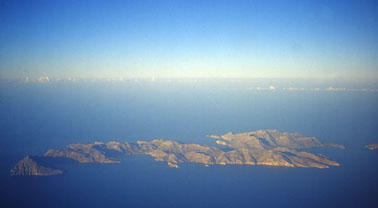
The island of Tilos from above |
Like the
other islands in the Dodecanese, it remained under Italian rule from
1912 to 1943, and it was finally unified with Greece in 1946. There
aren’t many visible signs of the Italian occupation, with the notable
exceptions of the building of the Port Authority (typical
‘Mediterranean’ fascist architecture), and of the very name of the
island, that from 1912 to the end of the Second World War was Piscopi,
probably due to a mistake by one cartographer. The name Piscopi can now
be seen on an old Italian Army map, shown in Livadia’s main street, that
was used by a professor of the University of York, who adjourned it and
made probably the most detailed tourist map that can be seen in the
whole Dodecanese. Quite useful, as the island is known specially for the
beauty of its walks, that lead (not without a lot of sweating) to
wonderful secluded beaches.
|
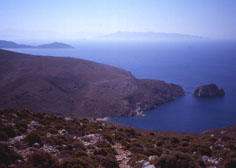
A long walk down
to Agios Sergios beach |
Very little is known about life in Tilos during the Italian occupation: as
usual, tourist books start from prehistory (bones from dwarf elephants
were discovered in a cave near the island’s
capital town, Megalo Horió), quickly move to mythology and
classical antiquity, tell tales of the resistance against the
Turks with the help of the Knights of St. John (a few castles
can still be seen), then jump over four centuries of Ottoman
domination, and explain how this was put to an end by Italians,
until the final liberation was achieved. Then there is almost no
trace about the remaining fifty, nearly sixty years, which
include abandoning the second largest village in the |
island, and the reader is gently led to today’s Tilos. A few
interviews with local people, and other sources, allowed me to
reconstruct some events, from the war onwards.
In his
autobiography, an Italian officer originally based in Rhodes, lieutenant
Luca Dogliani (2000), remembers that on September 8th 1943,
when the Italian government signed an armistice with the Allies, many
German troops were taken prisoners by overwhelming Italian forces
(35.000 versus 5.000). But the Governor, Admiral Inigo Campioni, after a
few days ordered his troops to
|
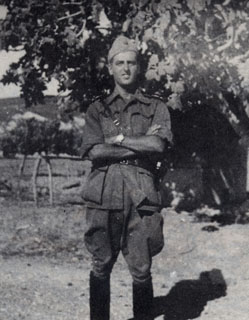
Lieutenant Luca Dogliani in 1943 |
surrender to the Germans
(this didn’t avoid him a trial and a death sentence from the
fascist
government of the Repubblica Sociale). Dogliani, who was
involved in capturing a German company, escaped to Halki, and
from there to Tilos. People from other islands – suffering from
the war’s starvation – got to know that three German motorboats
had been sunk in the bay of Livadia by British aircraft. One of
them carried a load of flour, in paper bags. Everyone knew that
under salty water flour forms a thick crust, that protects the
inside of the bag from the sea. So, boats from many nearby
islands went to Tilos in search of the precious bags. According
to some, the boat with part of its load could still be seen on
the bottom of Livadia bay in the Seventies. Dogliani was fed and
hidden by people in Agios Andonios, the second small port, near
Megalo Horió. |
War in
Tilos was similar to other small islands: occasionally commandos would
disembark, make some damage and leave. At some point, hundreds of
Germans disembarked in the bay of Tholós, on the Southern coast, and
reached Livadia. Few Greek patriots resisted with a machine gun: a
monument near Livadia’s port reminds their heroic resistance. Probably
later, a Cretan commando arrived near Megalo Horió from the bay of
Eristos, killed some Germans and left. German troops arrived,
threatening to kill all inhabitants that had escaped, as this was
evidence that they had helped the commando. Invited to translate,
Dogliani (who, of course, knew German, though he pretended to be Greek)
explained the German commander that it was dangerous to search the
houses, as all patients had escaped the leper hospital near Eristos bay,
to find refuge in their relatives’ houses. Hearing about leprosy
disturbed the Germans, and then the commander was content with killing
two lepers, guilty of having stolen boots from two of the killed
soldiers. But the village was saved from more killings and fire.
|
Of course, you won’t find any trace of the leper hospital in
tourists books (it was close to the largest beach in Tilos), and
very little is said also of the villages that were abandoned in
the Fifties. One, Ierá, was a summer village for the farmers and
shepherds of Livadia (at that time, the whole population): all
houses (very small!), with palm and fig trees, are still there,
without roofs. A witness who was a child then told me that there
was even a small tavern, in Ierá (probably the place where I
collected a very old glass bottle of Peroni beer). |
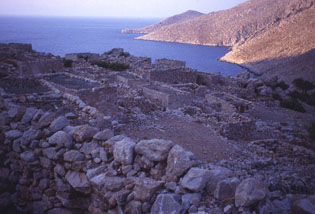
The abandoned village of Ierá |
|
Other small groups of houses were still used in the Fifties, in
some cooler locations over the hills, like Pano Meri. Traces of
very intense agricultural work can be seen all around the
island, with terraces apt to grow wheat and olive trees. Then,
at a short distance from the port of Livadia, one can visit
Micró Horió, that was also abandoned in the Fifties: not a
seasonal village, though. It was a rather big village, with a
church and many two-floor houses. The lack of water and the hard
life moved the inhabitants to Livadia: since then, it’s a ghost
village, with two exceptions. The old church is still used, and
hosts a festival on August 14th, and one of the
houses was restored to become Mikró Horió’s well known disco
bar. |
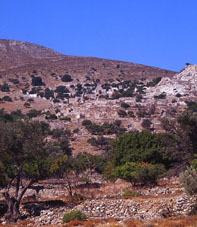
The abandoned village of Mikró Horió,
from the fields below |
|




